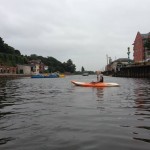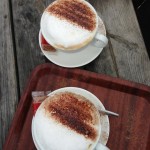Kayaks and Cappuccinos
Sunday, after our trip to Bath, we were given a free day. Although the forecast predicted consistent rain throughout the day, Veronica and I were adamant that our kayak reservations would not be in vain. With raincoats and a change of clothes in hand, we headed to the Quay to pick up our single kayaks. After asking for suggestions from the Saddles and Paddles staff, we decided to use our two hour reservation to paddle towards the Double Locks Pub (about 30-45 minutes). Once we were dockside and preparing to get into our kayaks, the true meaning of “wet boating” became clear to me. Both kayaks had a solid inch or so of water in them along with some interesting looking sea greenery. Veronica and I both shrugged and silently thanked ourselves for the forethought to bring a change of clothes before jumping in (actually I kind of slid in by sitting on the dock). Once we got going, the trip was absolutely beautiful! Paddling down the canal was so peaceful, and the surrounding scenery of green meadows with bike paths along the canal was wonderful. For me, it was odd to not have to look out for gators along the way, and the only creatures we came across were water gliders (besides the occasional fellow paddler). After passing by boats, houses, and green space and ducking underneath two bridges, we reached The Double Locks Pub. We literally flopped onto the deck from the kayaks, and then took the time to walk around the Pub grounds and drip-dry(this pub hosts lots of community events and has a huge tent and picnic area). Once the pub opened, we went inside to get two of the best cappuccinos I have ever had! I don’t know if it was our level of wet/coldness or the fact that the coffee really was fantastic, but once we finished, we felt ready to make the trip back.
Just as we had figured out how to slide into our kayaks again, the rain started. Some people may have been mad, but we were already completely wet from the boats and felt the rain just made the trip back more fun. Watching the drops hit the water ahead of us and hearing the sound of the rain on our coats just made the trip that much more enjoyable and, in our minds at least, more English.
After we got back to the Quay, we changed clothes and went to Waterfront Restaurant where we met up with more friends and ate a fabulous pizza. All in all, it was a relaxing day after the whirlwind of Bath and before classes started again for the week.
- Kayaking on the Canal
- Beautifully Delicious Waterfront Pizza
- Double Locks Cappuccinos
Monday, we had two lectures. Our first was given by our pathway coordinator, Prof. Williams, who discussed in depth the relationship between physical activity levels and health across the lifespan. That afternoon, we were taught by Dr. Winsley from the St. Luke’s Campus who helped us explore the debate of when and if children should be given the right to make decisions about their health, specifically how much physical activity they do. We split into two groups and constructed debates in support of or against a mandatory 60 min/day activity requirement for children. It was really helpful to use the resources from our morning and other previous lectures to construct our arguments and bring together what we have learned over the past several weeks. After lectures, I stayed for a short session on graduate study in the UK to find out more about the process of applying and being an international student.
Today in lecture we discussed the development of cardiovascular disease risk factors with Dr. Barker. It was scary to see the impact that having one major risk factor for cardiovascular disease has on your overall risk of a cardiac incident. Even more enlightening was the fact that the presence of some risk factors can be seen in kids. In fact, fatty streaks, precursors to atherosclerosis, have been seen in the blood vessels of kids as young as ten! And, the longer someone is under “risk,” the worst their chance of actually having medical problems later in life. This afternoon, the health advice continued with Dr. Garcia-Marco who lectured on the relationship between bone health and physical activity. According to him, fitness level may be a better indicator of health than activity level, even though the two are often closely related. Even increasing someone’s fitness to 25% of the optimal level has a HUGE impact on their health in the long term. After discussing the types of “impact” exercises which build up bone density, we were able to test our own bone density using a portable machine which ultrasounds your heel bone. The machine even prints out a “receipt” of your scan and density level compared to the normal US levels. It was interesting to be able to test one another and use the machine to follow up our lecture, and I am looking forward to our accelerometer experiments later this week.


